Brain breaks and movement breaks are essential tools for helping kids maintain focus, stimulate their neural networks, and boost their mood.
Taking short breaks from structured activities is a great way for kids to rejuvenate their minds and enhance their ability to absorb new information.
It’s like giving their brain a refreshing boost! Such a game-changer, especially for the middle of the school day.
Let’s explore some of the most enjoyable and beneficial brain and movement breaks for kids in school or at home.
These activities are not only fun, but they also foster creativity, enhance cognitive abilities, and promote physical fitness.

What are Brain Breaks and Movement Breaks?
Brain breaks and movement breaks are short mental or physical exercises that allow children to take a break from their learning activities.
These breaks can include simple stretches, dance moves, yoga poses, or fun games that get kids moving and help them release excess energy.
These activities aim to activate different parts of the brain, promote mental alertness, and improve mood and behavior.
Crossing midline activities in particular are a great way to kids kids brains activated and enhance cognitive abilities at any age.
Benefits of Brain Breaks and Movement Breaks for Kids
It is essential to incorporate brain breaks and movement breaks into children’s daily routines, especially for those who spend most of their day sitting in a classroom.
These activities promote physical fitness, enhance cognitive abilities, and boost mood and overall well-being.
Some of the key benefits of brain breaks and movement breaks include:
- Improved academic performance: Research shows that regular physical activity can enhance children’s cognitive abilities and boost academic performance.
- Increased focus and concentration: Regular brain breaks enhance attention span and focus on learning tasks.
- Reduced stress and anxiety: Brain breaks release tension, promoting relaxation and reducing stress and anxiety levels.
- Better behavior: Movement breaks help children release energy, leading to improved behavior and focus in the classroom.
- Enhances mood: Brain breaks release endorphins, improving mood and behavior, and creating a positive and productive learning environment.
- Reduced risk of obesity: Incorporating physical activity into daily routines helps prevent childhood obesity, a growing concern worldwide.
Quick Movement Brain Break Ideas
Scroll down for the printable “card” version of these awesome brain breaks!
Washer/Dryer
Washer: stand with feet hip distance apart, arms bent, elbows at your sides. Bend your knees slightly, and rotate your torso side to side, like a washing machine doing up some clothes.
Dryer: Either spin your fists around one another like punching a boxing bag while blowing on your hands OR bend at the hips to “pick up clothes” and “hang them” high above your head on the line to dry
Sun Salutation
A basic yoga sun salutation is great for helping the core and balance:
- Reach up high for mountain, then bend into forward fold.
- Plant your hands and step back into plank.
- Lower down, then lift the torso for cobra.
- Breathe in and out, then press back into down dog.
- Step forward again to forward fold, then reach back up high to mountain.
Learn more about amazing yoga sequences for kids here.
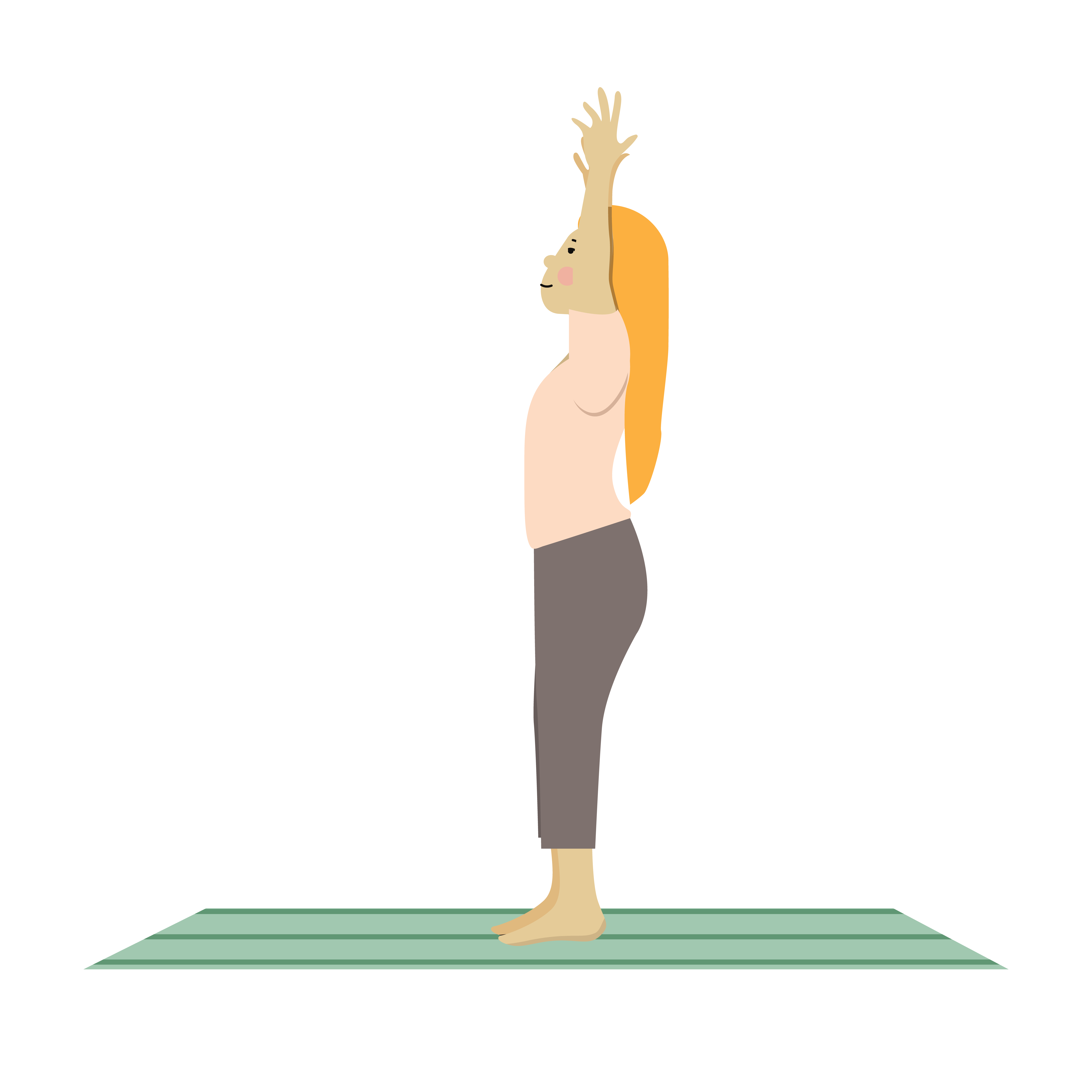
Zap finger find with a friend
Stand back to back with a friend. One person is the zapper first, putting their finger somewhere to the side either up or down, and the other person needs to find the finger and “zap” it with their own.
Switch after 5-10 zaps, switching hands as well.
Pass the ball over/under with a friend
Stand back to back (not quite touching) with a friend with your feet slightly wider than hip distance. One person passes the ball over their head to the receiver, who takes the ball and passes it between their legs.
Keep passing it in the same direction, then go the other way.
Windmill arms
Stand with feet wide. Reach up in star pose, then reach one hand down to the opposite foot. Come back up to star pose, then reach the other hand to the other foot.
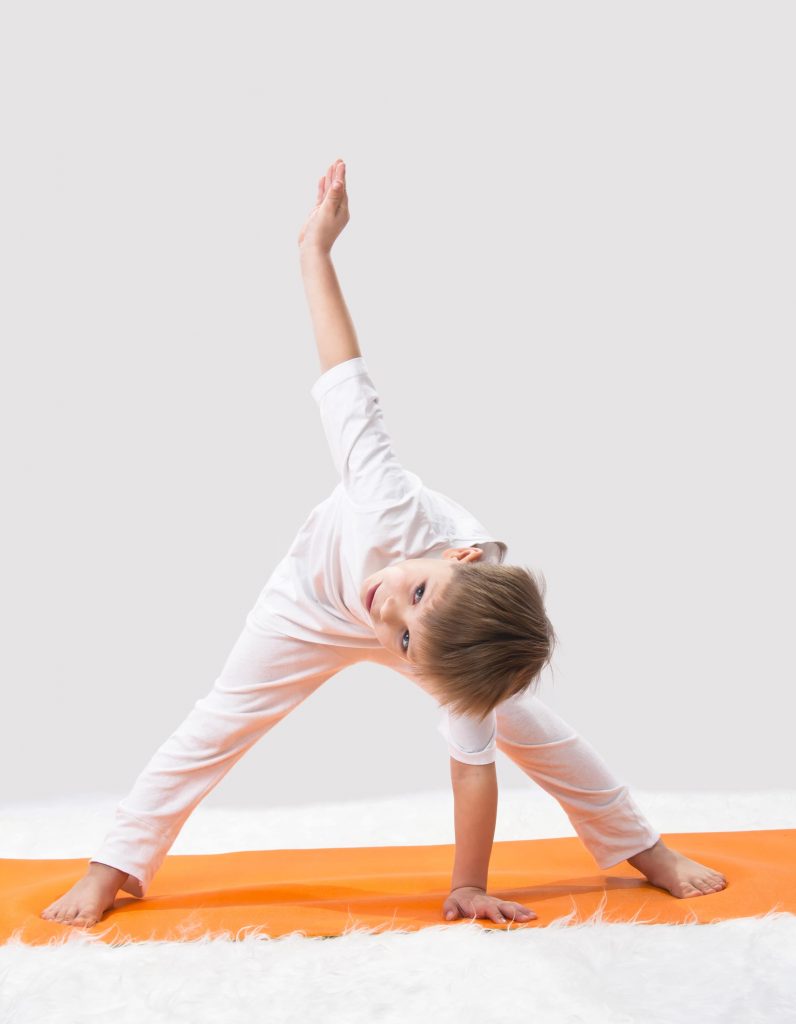
Boat hand and foot crossover
This is another cross-body hand-to-foot action but done in Boat pose. Reach your hands up above your head while balancing on your sit bones, then reach for your opposite knee or foot.
This is great for core strength and coordination. Try it with your legs straight for an extra challenge!
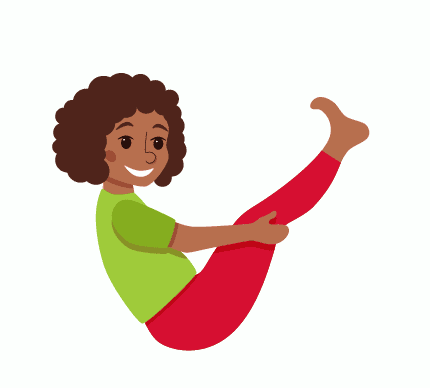
Tippy toes and heel balance
Balancing alternatively on your toes and then your heels is good for balance practice, core strength, and foot articulation.
Some kids move their hands at the same time which is cute to point out. It also gets them to be mindful when they have to focus on such small movements.
Try these other mindfulness games and activities for kids, too.
Cross crawls (or knee bumps)
This one is great for kids of any age. Start marching with high knees, but touch your elbow to your opposite knee and then the other side.
Try to reach your hand to your opposite foot for an extra challenge and hamstring stretch.

Dinosaur, Dinosaur Rhyme
Reach down and grab your ankles for Dinosaur pose.. Then act out the actions to this poem while you’re doing the poem. Keep your hands on your ankles for the first two, and then again for the last two.
- Dinosaur, dinosaur turn around
- Dinosaur, dinosaur stomp the ground
- Dinosaur, dinosaur show your claws
- Dinosaur, dinosaur chomp your jaws
- Dinosaur, dinosaur turn around
- Dinosaur, dinosaur sit back down

Spin jumps
Point out a few key objects in different directions of the classroom that the kids will need to spin and jump to face when you call it out.
It helps to tell them to jump like a snowboarder, with their feet apart and attached to a pretend board.
Then you say for example, “jump face clock! Desk! Door!” etc, and vary it so they are spinning in different directions each time.
Mountain Climbers
Start in high plank pose. Bring one knee up to your elbow, either the same elbow, or cross it over for an added challenge. Then do the other knee! Keep going and use your core for strength.
Many kids end up running their feet instead of doing the full movement, but that’s ok too.
Tiger Taps
Kneel on your hands and knees. Reach your right arm forward and your left foot back. Balance! Then, reach your arm around behind you and try to tap your left foot. Switch and do the other side.

Fun Brain Break Games and Activities
Here are some fun game ideas to incorporate brain breaks and movement breaks in the classroom. These may take a few more minutes to do, since they may take more time to explain the first few times, or there may be some set up.
Play Simon Says (or Yogi Says!)
This classic game is a great way to get kids moving and following instructions. To make it more challenging, add in fun movements like “Simon says hop on one foot” or “Simon says do five jumping jacks.”
Use this free list of Yogi Says prompts to keep the game moving quickly.
5 4 3 2 1 Shakes
This is a quick and easy game to get out the wiggles. Have students stand up and shake each arm and leg for 5 seconds, then 4 seconds, and so on until they reach 1 second of shaking each.
It sounds like this:
Right arm! 5-4-3-2-1
Left arm! 5-4-3-2-1
Right leg! 5-4-3-2-1
Left leg! 5-4-3-2-1
(Start over with R arm) 4-3-2-1
4-3-2-1
4-3-2-1
4-3-2-1
3-2-1
3-2-1
3-2-1
3-2-1
(keep going until you do just 1 shake of each limb! Very silly and fast-paced.
Freeze Dance
Play some upbeat music and have kids dance around. When the music stops, they have to freeze in whatever position they are in. For added fun, have them try to hold a yoga pose when the music stops instead of just freezing.
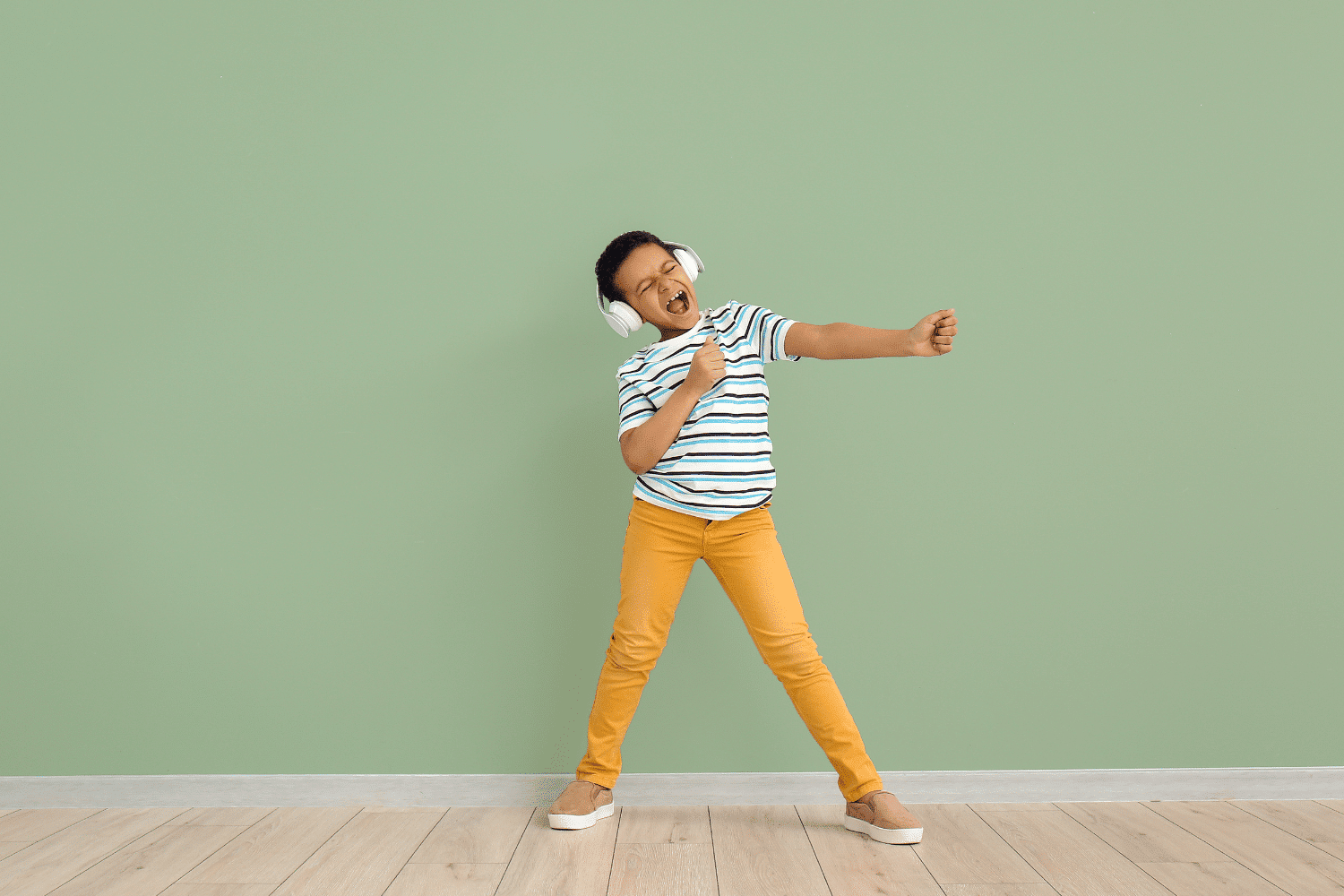
Dance Party
Put on some upbeat music and let the kids dance their hearts out! Not only is this a great way to get their bodies moving, but it’s also a fun and creative outlet for their energy.
Encourage them to come up with their own dance moves or follow along with one person’s moves to help them work on copying and mirroring skills.
Obstacle Course
Set up a simple obstacle course in the classroom or outside using items like hula hoops, cones, and jump ropes. Have the kids go through the course one at a time, or make it a race and have them compete against each other.

Animal Walks
Have the kids mimic different animal movements, like crawling like a bear or hopping like a kangaroo. This not only gets them moving, but it’s also a great way to incorporate imaginative play.
- Crab Walk: Sit on the ground, lift your body with your hands and feet, and start moving sideways. Feels crabby, doesn’t it?
- Duck Waddle: Squat low and walk forward, keeping your hands on your waist. Just like a duck, waddle waddle!
- Frog Jump: Crouch down, touch the ground with your hands, and then leap forward. You’re jumping high like a frog!
- Kangaroo Hop: Stand tall, bring your knees together, and bounce forward on your imaginary tail. Hop, Hop like a kangaroo!
- Elephant Stomp: Act out a mighty elephant by stomping your feet as you walk, swinging your arm like a trunk for added fun!
- Giraffe Stride: Walk tall and slow, stretching your neck high up. Feel elegant like a giraffe?
- Cheetah Sprint: Get on all fours and dash forward. Can you be as agile as a cheetah? Keep practicing!
- Monkey Strut: Stand with your feet apart, toes out a little, and knees and arms bent. “Gallop” like a monkey around the room, swinging your arms as you go.
- Turtle Roam: Crawl slowly, slowly like a turtle, almost sliding across the floor. Can you make it to the finish line before anyone else?
- Snake Slither: Lie on your stomach and push yourself up with your hands, moving forward using a snake-like motion. It’s like you’re sliding across the ground!
Yoga or Stretching
Set aside some time for calming brain breaks by incorporating yoga poses or stretching exercises. This can help children relax and refocus their minds.
Let’s dive into our top five yoga poses that are perfect for kids.
- Tree Pose (Vrksasana): Start by standing straight, then balance on one foot while bending the other knee to the side. Place the sole of the bent leg either above or below the knee of your standing leg. Hold your hands up above your head like the branches of a tree. Can you feel how strong and calm trees must be?
- Cobra Pose (Bhujangasana): Lie flat on your stomach, then push up with your hands under your shoulders, keeping a slight bend in the elbows. Lift your chest and head, tilting your head back. Snake charming has never been so fun!
- Butterfly Pose (Baddha Konasana): Sit with your feet together, knees out to the sides. Flutter your knees up and down – just like a butterfly flapping its wings!
- Warrior Pose (Virabhadrasana): Stand tall, then step one foot back, bending the front knee. Reach your hands up towards the sky. Feel the strength in your legs and show off your muscles.
- Happy Baby Pose (Ananda Balasana): For this, lie on your back and grab your feet with your hands, knees bent towards your armpits. Now rock from side to side like a happy baby.
Remember, it’s not about doing these poses perfectly, it’s all about having fun and giving ourselves those mental brain breaks!
Take a closer look at yoga for kids and how to teach it to students of all ages.
Scavenger Hunt
Hide small objects around the room or outside and have the kids search for them while incorporating different movements, like crawling or jumping.
This is a fun way to get both their bodies and brains working as the students stand and move around the room.
Or if you are at home, use these ideas for an awesome backyard scavenger hunt!

Alphabet Activities
Have the kids do an activity for each letter of the alphabet, like jumping jacks for “J” or hopping on one foot for “H.” This not only gets them moving, but it also helps reinforce letter recognition and phonics.
Fitness Challenge
Create a list of physical challenges, such as doing 10 push-ups or holding a plank for 30 seconds. Have the kids complete the challenges and track their progress over time, encouraging them to beat their personal best.
5 4 3 2 1 Fitness Brain Break
5-4-3-2-1? In this simple game, kids can take part in five different physical activities. Similar to above, just choose 5 different movements and assign them to a different number each.
For example, do five jumping jacks, four-star jumps, three sit-ups, two push-ups, and one burpee. Create a big list at first, and choose the five different things you want to do.
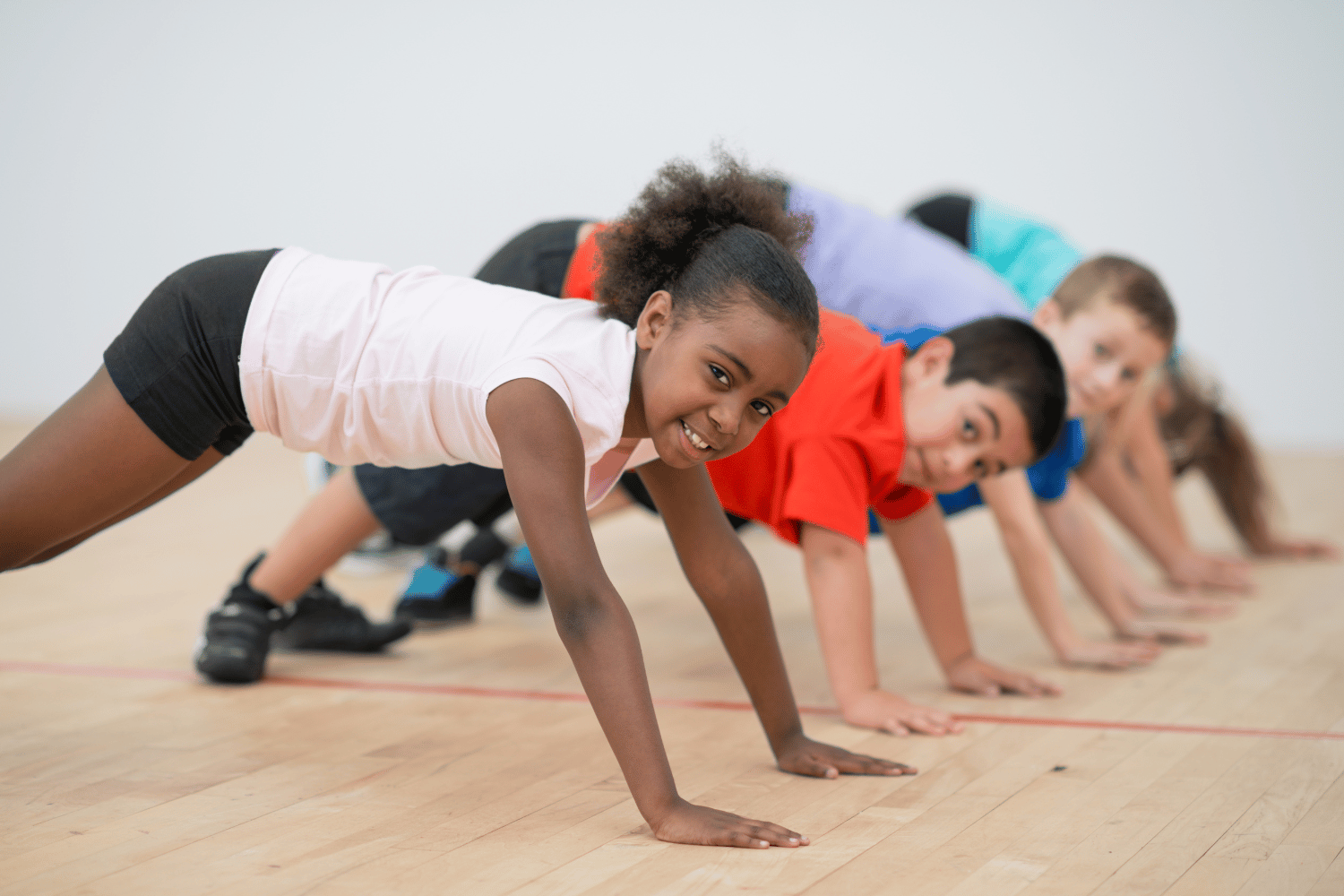
Brain Break Charades
Write down different physical activities on pieces of paper and have the kids act them out for a fun game of charades. Keep it simple for younger kids, like pretending to be different animals.
Then for older students, you can have them be partners and act out more complicated activities.
This is a great way to incorporate movement while also promoting problem-solving and communication skills.
Heads Up Seven Up
This classic game is a perfect brain break for any age. Have seven students come up to the front of the room and choose one student to stand in front of each of them. The chosen students put their heads down while everyone else closes their eyes.
The seven standing students then go find one person’s thumb to tap or press down, sneakily. The seven students return to the front of the room and the chosen students then stand up and have to guess who tapped their thumb.
If they guess correctly, they switch places. This game promotes focus and quick thinking while also incorporating physical movement as students switch places.
Active Spelling Bee
Incorporate physical activity into a traditional spelling bee by having participants do a different exercise for each letter in the spelling word.
For example, if the word is “s l i d e”, have participants do a fun foot slide for each letter in the word. This keeps students engaged and active while also practicing their spelling skills.
Wall Push Ups
Have the kids do push-ups against a wall for an easy and effective way to build upper body strength. Remind them to keep their bodies straight and engage their core muscles while performing the exercise.
Take Deep Breaths
Use your whole body to take deep breaths while standing. Inhale as you raise your arms above your head and exhale as you lower them back down. This can help release tension and increase focus.
Try this fun breathing exercise for kids with some smaller movements.

Watch a Calming Video for Mindfulness
There are lots of great videos that can help students learn mindfulness and take three to five minutes to breathe deeply and work on self-regulation.
Check out these awesome mindfulness videos for kids.
Get a printable version of these movement brain break ideas here:
How to Implement Brain Breaks and Movement Breaks in the Classroom
Implementing brain breaks and movement breaks in the classroom is a great way to motivate your students and enhance their learning experience.
Here are some tips for incorporating them into your daily routine.
Schedule designated brain break times
Plan specific times throughout the day for brain breaks, such as after a long lesson or before a test. This allows students to anticipate and prepare for these brief periods of movement.

Keep them short
Brain breaks should be no longer than 5-10 minutes. This allows students to re-energize without completely disrupting the flow of the lesson.
Involve students in the process:
Ask for student input when choosing brain break activities. This helps engage them and gives them a sense of ownership over their own learning. Call on students randomly to let them choose their favorite brain break.
Mix it up
Vary the types of brain breaks you incorporate. Use a jar of printed out brain break cards to make it truly random each time.
Incorporate them into lessons
Use movement-based activities as a way to reinforce concepts or material being taught in class. For example, have students act out vocabulary words through charades or use an obstacle course to review math facts.
Combining yoga with academics is always entertaining and good for your brain too.
Conclusion
Incorporating brain breaks and movement breaks in the classroom can have numerous benefits for both teachers and students. It not only helps keep students engaged and motivated, but it also allows them to release pent-up energy and refocus on the lesson.
By following the tips mentioned above, you can successfully integrate these breaks into your daily routine and create a more dynamic learning environment for your students. So go ahead and give it a try – your kids (and you) will thank you for it!
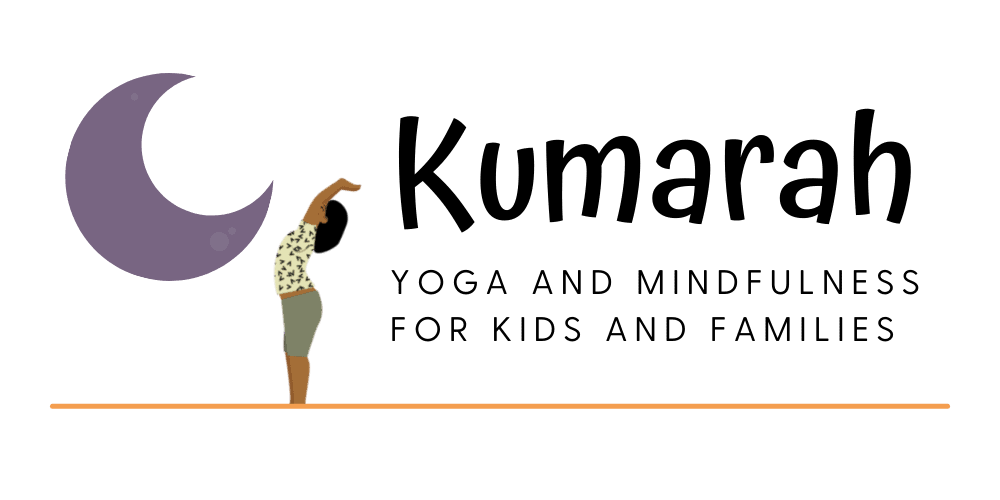

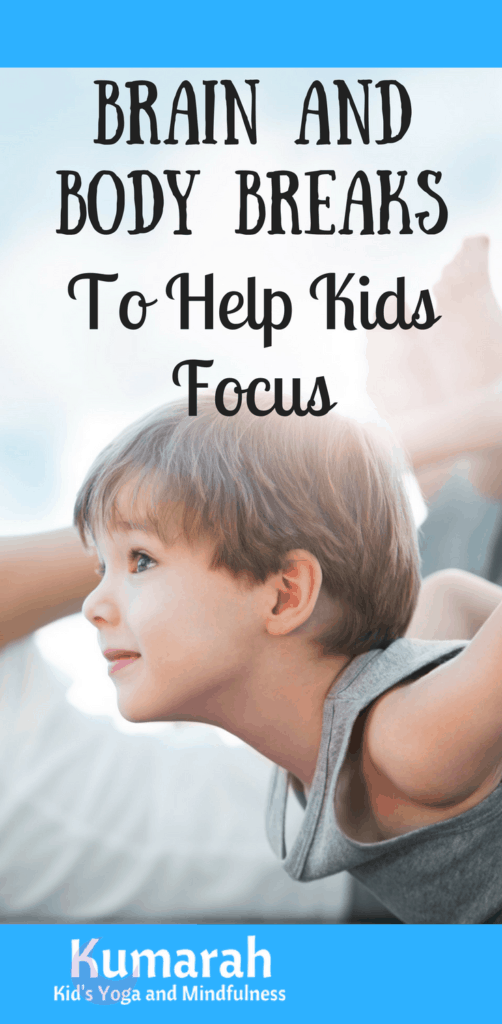


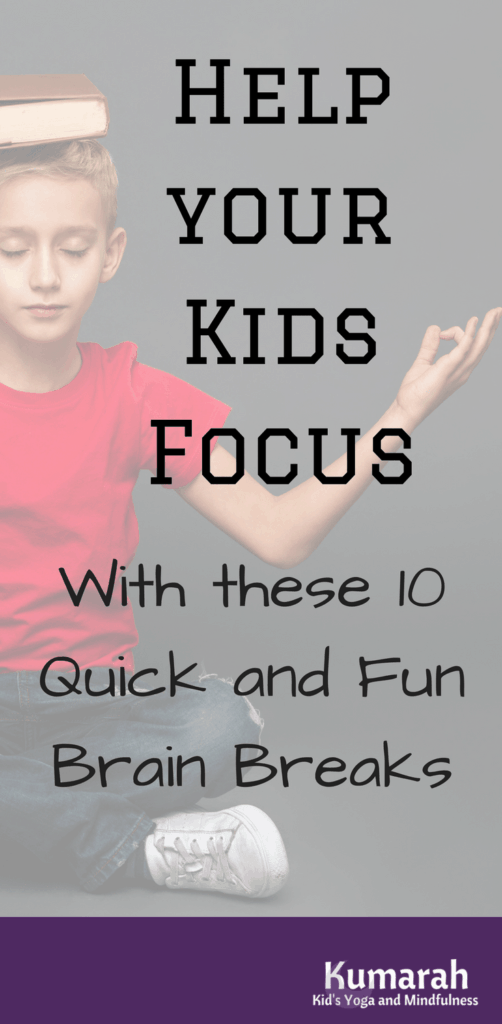
Fantastic ideas, thanks for sharing them! In case anyone’s wants more ideas, I found these exercises as well: https://westendinschools.org.uk/blog/creative-classroom-management-part-2
Have a great day, cheers!
– Paul
Thank you Paul! And thanks for sharing some additional breaks as well– we do the rubber chicken also, I’ve just never called it that 😂 I will have to start!